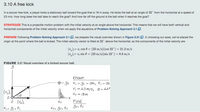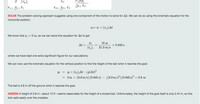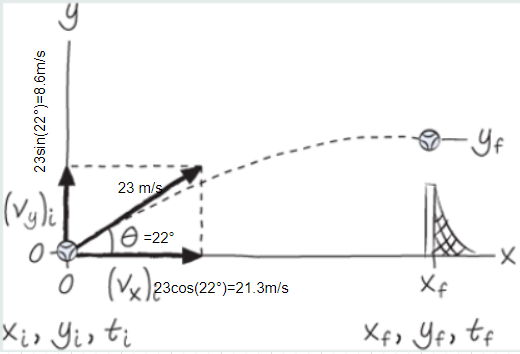Match the answers with questions based on Example 3.10 (I attached pictures of example 3.10 from the textbook)
1.) ball's initial speed
2.) ball's initial speed along the x-component
3.) ball's initial speed along the y-component
4.) ball's initial velocity
5.) ball's acceleration along the y-component
6.) ball's acceleration along the x-component
| A. |
23 m/s, 22° from the horizontal |
| B. |
9.8 m/s2 |
| C. |
-9.8 m/s2 |
| D. |
8.6 m/s |
| E. |
23 m/s |
| F. |
0 |
| G. |
21.3 m/s |


The velocity has a magnitude and a direction, the magnitude is called speed.
The horizontal and vertical components of the velocity are shown in figure below.

In projectile motion the x and y directions are independent, as gravity acts only vertically the x direction is unaffected, hence in horizontal direction the particle moves with constant velocity whereas vertically it experiences acceleration due to gravitation.
Trending nowThis is a popular solution!
Step by stepSolved in 2 steps with 1 images

- Help me with that please last 2 parts pleasearrow_forward5. 00 2 Part A The motions described in each of the questions take place at an intersection on a two-lane road with a stop sign in each direction. For each motion; select the correct position versus time graph. For all of the motions, the stop sign is at the position x = x direction.(Figure 1) A driver ignores the stop sign and continues driving east at constant speed. 0, and east is the positive • View Available Hint(s) O A O F Submit Part B Figure K 1 of 1 A driver ignores the stop sign and continues driving west at constant speed. A B ► View Available Hint(s) 14 O A E 14 O F n/myct/itemView?assignmentProblemID=165218943&offset=next 000 000 F4 DD F5 F6arrow_forwardPlease help me. Make sure to give clear answers for all the parts and this problem has 2 parts.arrow_forward
- Use the VELOCITY vs. TIME graph below to answer the following questions. Let west be the positive direction & east be the negative direction. Express all answers in the appropriate mks units. [NOTE: m/s² should be entered as m/s^2.] VELOCITY vs. TIME GRAPH X-velocity (m/s) A.) Over what period of time was the object speeding up? 15 s to 25 s B.) Over what period of time was the object slowing down? 100 Os to 10 s C.) Over what period of time was the object's velocity constant? 50 10 s to 15 s D.) State the magnitude & direction of the object's acceleration at 3 s. west - 50 E.) State the magnitude & direction of the object's acceleration at 13 s. south - 100 F.) State the magnitude & direction of the object's acceleration at 16.5 s. t (s) 25 10 15 20 northarrow_forwardPlease solve I've tried so many waysarrow_forwardNeed help with this practice prob2 Thank youarrow_forward